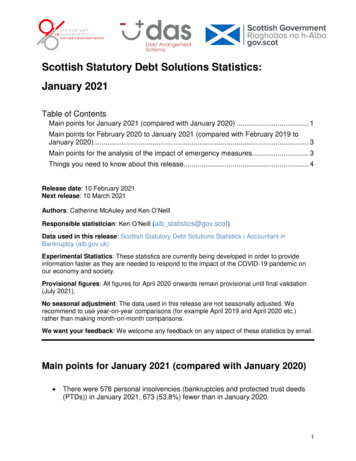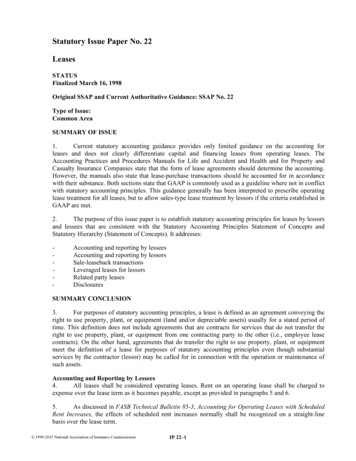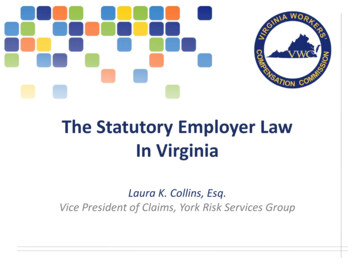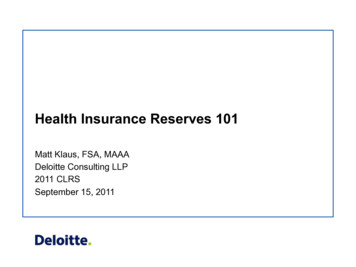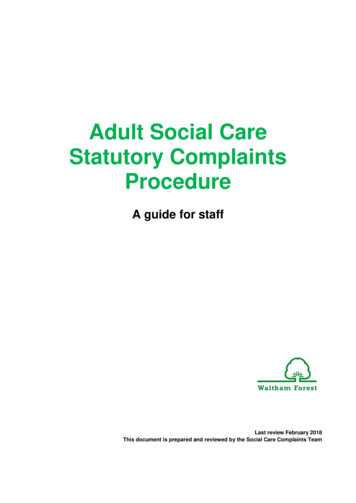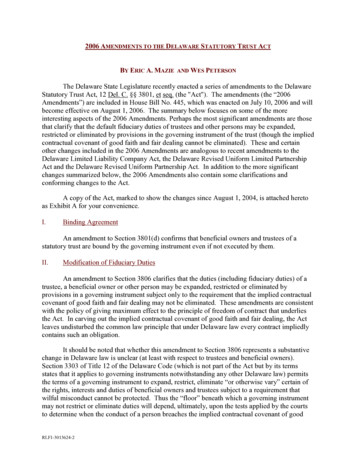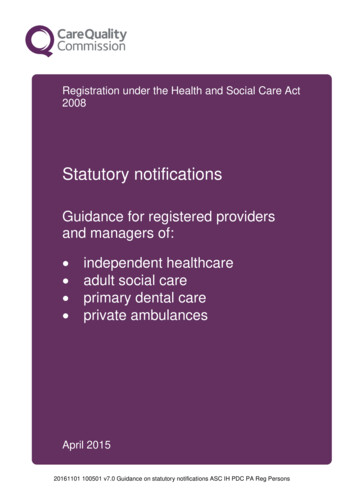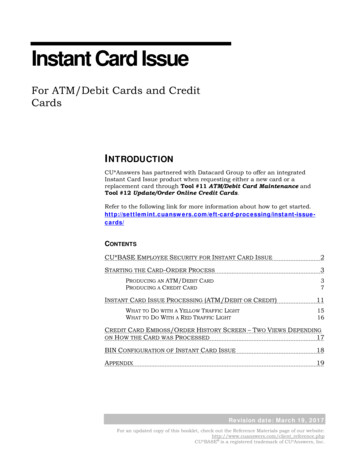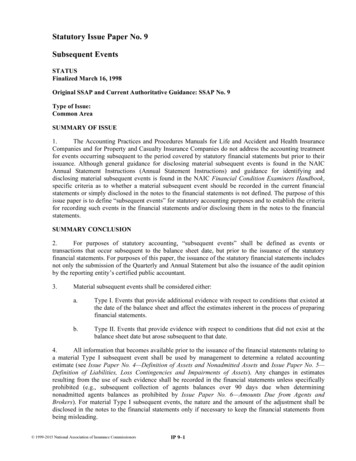
Transcription
Statutory Issue Paper No. 9Subsequent EventsSTATUSFinalized March 16, 1998Original SSAP and Current Authoritative Guidance: SSAP No. 9Type of Issue:Common AreaSUMMARY OF ISSUE1.The Accounting Practices and Procedures Manuals for Life and Accident and Health InsuranceCompanies and for Property and Casualty Insurance Companies do not address the accounting treatmentfor events occurring subsequent to the period covered by statutory financial statements but prior to theirissuance. Although general guidance for disclosing material subsequent events is found in the NAICAnnual Statement Instructions (Annual Statement Instructions) and guidance for identifying anddisclosing material subsequent events is found in the NAIC Financial Condition Examiners Handbook,specific criteria as to whether a material subsequent event should be recorded in the current financialstatements or simply disclosed in the notes to the financial statements is not defined. The purpose of thisissue paper is to define “subsequent events” for statutory accounting purposes and to establish the criteriafor recording such events in the financial statements and/or disclosing them in the notes to the financialstatements.SUMMARY CONCLUSION2.For purposes of statutory accounting, “subsequent events” shall be defined as events ortransactions that occur subsequent to the balance sheet date, but prior to the issuance of the statutoryfinancial statements. For purposes of this paper, the issuance of the statutory financial statements includesnot only the submission of the Quarterly and Annual Statement but also the issuance of the audit opinionby the reporting entity’s certified public accountant.3.Material subsequent events shall be considered either:a.Type I. Events that provide additional evidence with respect to conditions that existed atthe date of the balance sheet and affect the estimates inherent in the process of preparingfinancial statements.b.Type II. Events that provide evidence with respect to conditions that did not exist at thebalance sheet date but arose subsequent to that date.4.All information that becomes available prior to the issuance of the financial statements relating toa material Type I subsequent event shall be used by management to determine a related accountingestimate (see Issue Paper No. 4—Definition of Assets and Nonadmitted Assets and Issue Paper No. 5—Definition of Liabilities, Loss Contingencies and Impairments of Assets). Any changes in estimatesresulting from the use of such evidence shall be recorded in the financial statements unless specificallyprohibited (e.g., subsequent collection of agents balances over 90 days due when determiningnonadmitted agents balances as prohibited by Issue Paper No. 6—Amounts Due from Agents andBrokers). For material Type I subsequent events, the nature and the amount of the adjustment shall bedisclosed in the notes to the financial statements only if necessary to keep the financial statements frombeing misleading. 1999-2015 National Association of Insurance CommissionersIP 9–1
IP No. 9Issue Paper5.Information that becomes available prior to the issuance of the financial statements relating to amaterial Type II subsequent event shall not be recorded in the financial statements, but shall be disclosedin the notes to the financial statements. If an event is of such a nature that pro forma disclosures arenecessary to keep the financial statements from being misleading, disclosure of supplemental pro formafinancial data shall be made including the impact on net income, surplus, total assets and total liabilitiesgiving effect to the event as if it had occurred on the date of the balance sheet.6.The conclusions in this issue paper, including the disclosures in paragraph 5, shall also apply toquarterly statement filings.DISCUSSION7.The above conclusion expands and clarifies the guidance provided in the NAIC FinancialCondition Examiners Handbook and the Annual Statement Instructions by requiring that Type Isubsequent events be recorded in the financial statements.8.The Statutory Accounting Principles Statement of Concepts and Statutory Hierarchy (Statementof Concepts) states that “the cornerstone of solvency measurement is financial reporting. Therefore, theregulator’s ability to effectively determine relative financial condition using financial statements is ofparamount importance to the protection of policyholders.” The recording of Type I subsequent eventsprovides the regulator relevant information to evaluate the financial condition of an entity. However, insome circumstances, the recording of Type I subsequent events is specifically prohibited withinCodification (e.g., subsequent collection of agents balances over 90 days due when determiningnonadmitted agents balances).9.Identifying events that require adjustment of the financial statements under the criteria stated inthe conclusion calls for the management of the entity to exercise judgment and accumulate knowledge ofthe facts and circumstances surrounding the event. For example, a loss on an uncollectible agent’s balanceas a result of an agent’s deteriorating financial condition leading to bankruptcy subsequent to the balancesheet date would be indicative of conditions existing at the balance sheet date, thereby requiring therecording of such event to the financial statements before their issuance. On the other hand, a similar lossresulting from an agent’s major casualty loss such as a fire or flood subsequent to the balance sheet datewould not be indicative of conditions existing at the balance sheet date and recording of the event to thefinancial statements would not be appropriate. However, this is a Type II subsequent event which wouldrequire disclosure in the notes to the financial statements as described in paragraph 5 above.10.Additionally, the Statement of Concepts states that “Because these basic financial statementscannot be expected to provide all of the information necessary to evaluate an entity’s short-term andlong-term stability, management must supplement the financial statements with sufficient disclosures(e.g., notes to the financial statements, management’s discussion and analysis, and supplementaryschedules and exhibits) to assist financial statement users in evaluating the information provided.”Disclosure of Type II subsequent events meets this objective. Examples of Type II events that requiredisclosure to the financial statements (but should not result in adjustment) are: i) sale of a bond or capitalstock issue, ii) purchase of a business, iii) settlement of litigation when the event giving rise to the claimtook place subsequent to the balance sheet date and iv) casualty losses resulting from a hurricane orearthquake subsequent to the balance sheet date.Drafting Notes/CommentsNone 1999-2015 National Association of Insurance CommissionersIP 9–2
Subsequent EventsIP No. 9RELEVANT STATUTORY ACCOUNTING AND GAAP GUIDANCEStatutory Accounting11.The Annual Statement Instructions for Life and Accident and Health Insurance Companiesrequire disclosure of subsequent events in the notes to the financial statements as follows:Events SubsequentInstruction:Describe any events occurring subsequent to the close of the books or accounts for thisstatement which may have a material effect on the financial condition of the company.Illustration:On February 1, 19 , the Board of Directors adopted a plan for recapitalization subject toshareholder approval, which would effect an amendment to the Certificate of Incorporation toincrease the authorized common shares from to .12.The Annual Statement Instructions for Property and Casualty Insurance Companies is similar tothe Life and Accident and Health instructions above.13.Part 1, Section 5, Report on Full Scope Examination, of the NAIC Financial ConditionExaminers Handbook discusses reporting of transactions consummated subsequent to the effective date ofthe examination as follows:Any transaction consummated by a company subsequent to the effective date of an examination,which is for the purpose of adjusting the company’s previously reported financial condition, shallnot be recognized in the preparation of the examiner’s financial statement in the report ofexamination.Such transaction may be described by a qualifying statement, or statements, when supported bya reference to the original minutes or document evidencing such subsequent transaction ortransactions. Such supporting data shall be set forth in a clearly captioned appendix orappendices to the report.14.Exhibit G to Part 1 (General) of the NAIC Financial Condition Examiners Handbook provides alist of procedures to assist in identifying subsequent events but does not provide guidance as to thetreatment of the events once identified. A list of the procedures are as follows:EXHIBIT G-REVIEW OF EVENTS SUBSEQUENT TO THE BALANCE SHEET DATECompany Examination Date Approved ByGenerally, the period of review of post-balance sheet events extends from the date of thebalance sheet to the date of the examination report, which in most cases is the date ofsubstantial completion of the fieldwork. It is usually not possible, however, to extend allprocedures to the same date. If delivery of the examination report is unduly delayed,consideration should be given to extending the review to a later date.The workpaper should contain specific information as to the scope of investigation of subsequentevents and the consideration given to each of them. Procedures related to subsequent eventsthat extend into the subsequent period include, but are not necessarily limited to, the itemsdescribed below. 1999-2015 National Association of Insurance CommissionersIP 9–3
IP No. 9Issue Paper1.Scan cash receipts records for evidence of proceeds of loans, significant sales ofproductive assets or other unusual items.Amounts over Date through2.Scan cash disbursements records for unusual payments and payment of liabilities notrecorded as of balance-sheet date.Amounts over Date through3.Review general journal entries for entries that would have a material effect upon thefinancial statement as of balance sheet date.Amounts over Date through4.Read minutes of meetings to directors, stockholders and important committees up to thereport date. If minutes have not been prepared, obtain a written representation from thesecretary about matters dealt with at such meetings. Review draft (if any) or proxystatement to be issued to shareholders for matters that may affect the financialstatements.5.Read latest available interim financial statements. Compare them with the financialstatements being reported on and obtain explanations for any unusual items noted as aresult of the comparison.Amounts over Date through6.Inquire of officers and other executives having responsibility for financial and accountingmatters as to whether the interim statements have been prepared on the same basis asthat used for the statements under examination. (Indicate identity of statements andperiods covered.)Amounts over Date through7.Inquire of officers and other executives having responsibility for financial and accountingmatters (limited where appropriate to major locations) as to: (NOTE: Indicate personswith whom discussions were held and date and attach memoranda or commentsregarding significant matters discussed. Corporate office inquiries should extend to thereport date.)a.Whether any substantial contingent liabilities or commitments existed at thebalance-sheet date or at the date of inquiry.b.Whether there was any significant change in the capital stock or debt to the dateof inquiry.c.The current status of items in the financial statements being reported on thatwere accounted for on the basis of tentative, preliminary, or inconclusive data.d.Whether any other matters had occurred that would materially affect the financialstatements or operations of the company. This includes appropriate inquiries asto subsequent events of material affiliates accounted for by the equity method.Amounts over Date through8.If the above procedures produce responses that significantly affect the financialstatements, they should be confirmed in writing. This may be done in the letter ofrepresentations.Amounts over Date through 1999-2015 National Association of Insurance CommissionersIP 9–4
Subsequent EventsIP No. 9Generally Accepted Accounting Principles15.The primary source of GAAP authoritative guidance for the treatment of subsequent events isAICPA Statement on Auditing Standards No. 1, Section 560, Subsequent Events, which states thefollowing:.01An independent auditor’s report ordinarily is issued in connection with historical financialstatements that purport to present financial position at a stated date and results ofoperations and cash flows for a period ended on that date. However, events ortransactions sometimes occur subsequent to the balance sheet date, but prior to theissuance of the financial statements and auditor’s report, that have a material effect onthe financial statements and therefore require adjustment or disclosure in the statements.These occurrences hereinafter are referred to as “subsequent events.”.02Two types of subsequent events require consideration by management and evaluation bythe independent auditor.03The first type consists of those events that provide additional evidence with respect toconditions that existed at the date of the balance sheet and affect the estimates inherentin the process of preparing financial statements. All information that becomes availableprior to the issuance of the financial statements should be used by management in itsevaluation of the conditions on which the estimates were based. The financial statementsshould be adjusted for any changes in estimates resulting from the use of such evidence.04Identifying events that require adjustment of the financial statements under the criteriastated above calls for the exercise of judgment and knowledge of the facts andcircumstances. For example, a loss on an uncollectible trade account receivable as aresult of a customer’s deteriorating financial condition leading to bankruptcy subsequentto the balance-sheet date would be indicative of conditions existing at the balance-sheetdate, thereby calling for adjustment of the financial statements before their issuance. Onthe other hand, a similar loss resulting from a customer’s major casualty such as a fire orflood subsequent to the balance-sheet date would not be indicative of conditions existingat the balance-sheet date and adjustment of the financial statements would not beappropriate. The settlement of litigation for an amount different from the liability recordedin the accounts would require adjustment of the financial statements if the events, suchas personal injury or patent infringement, that gave rise to the litigation had taken placeprior to the balance-sheet date.05The second type consists of those events that provide evidence with respect toconditions that did not exist at the date of the balance sheet being reported on but arosesubsequent to that date. These events should not result in adjustment of the financialstatements.1 Some of these events, however, may be of such a nature that disclosure ofthem is required to keep the financial statements from being misleading. Occasionallysuch an event may be so significant that disclosure can best be made by supplementingthe historical financial statements with pro forma financial data giving effect to the eventas if it had occurred on the date of the balance sheet. It may be desirable to present proforma statements, usually a balance sheet only, in columnar form on the face of thehistorical statements.1 This paragraph is not intended to preclude giving effect in the balance sheet, with appropriate disclosure, tostock dividends or stock splits or reverse splits consummated after the balance-sheet date but before issuanceof the financial statements. 1999-2015 National Association of Insurance CommissionersIP 9–5
IP No. 9Issue Paper.06Examples of events of the second type that require disclosure to the financial statements(but should not result in adjustment) are:a.Sale of a bond or capital stock issue.b.Purchase of a business.c.Settlement of litigation when the event giving rise to the claim took placesubsequent to the balance-sheet date.d.Loss of plant or inventories as a result of fire or flood.e.Losses on receivables resulting from conditions (such as a customer’s majorcasualty) arising subsequent to the balance-sheet date.07Subsequent events affecting the realization of assets such as receivables andinventories or the settlement of estimated liabilities ordinarily will require adjustment ofthe financial statements (see paragraph .03) because such events typically represent theculmination of conditions that existed over a relatively long period of time. Subsequentevents such as changes in the quoted market prices of securities ordinarily should notresult in adjustment of the financial statements (see paragraph .05) because suchchanges typically reflect a concurrent evaluation of new conditions.08When financial statements are reissued, for example, in reports filed with the Securitiesand Exchange Commission or other regulatory agencies, events that require disclosurein the reissued financial statements to keep them from being misleading may haveoccurred subsequent to the original issuance of the financial statements. Eventsoccurring between the time of original issuance and reissuance of financial statementsshould not result in adjustment of the financial statements2 unless the adjustment meetsthe criteria for the correction of an error or the criteria for prior period adjustments setforth in Opinions of the Accounting Principles Board.* Similarly, financial statementsreissued in comparative form with financial statements of subsequent periods should notbe adjusted for events occurring subsequent to the original issuance unless theadjustment meets the criteria stated above.2 However, see paragraph .05 as to the desirability of presenting pro forma financial statements to supplementthe historical financial statements in certain circumstances.* See also Statement of Financial Accounting Standards No. 16, Prior Period Adjustments (AC section A35).RELEVANT LITERATUREStatutory AccountingStatutory Accounting Principles Statement of Concepts and Statutory HierarchyNAIC Annual Statement Instructions for Life and Accident and Health Insurance CompaniesNAIC Annual Statement Instructions for Property and Casualty Insurance CompaniesNAIC Financial Condition Examiners HandbookIssue Paper No. 4—Definition of Assets and Nonadmitted AssetsIssue Paper No. 5—Definition of Liabilities, Loss Contingencies and Impairments of AssetsIssue Paper No. 6—Amounts Due from Agents and BrokersGenerally Accepted Accounting PrinciplesAICPA Statement on Auditing Standards No. 1, Section 560, Subsequent EventsState RegulationsNo additional guidance obtained from state statutes or regulations. 1999-2015 National Association of Insurance CommissionersIP 9–6
IP No. 9 Issue Paper IP 9-2 5. Information that becomes available prior to the issuance of the financial statements relating to a material Type II subsequent event shall not be recorded in the financial statements, but shall be disclosed
